Report on Industrial Dispute and Moderated Discussion of IR Theory
VerifiedAdded on 2023/06/04
|15
|3786
|105
AI Summary
This MBA HRM assignment discusses an industrial dispute in the Rail Tram and Bus Union due to low wages and inflexible working conditions. It includes the positions of different parties involved, theories based on their roles, processes related to conflicts, adjustments to be made by managers and unions, and recommendations. The assignment also includes a moderated discussion of IR theory based on pluralism. Subject: Human Resource Management, Course Code: MBA HRM, University: Not mentioned
Contribute Materials
Your contribution can guide someone’s learning journey. Share your
documents today.
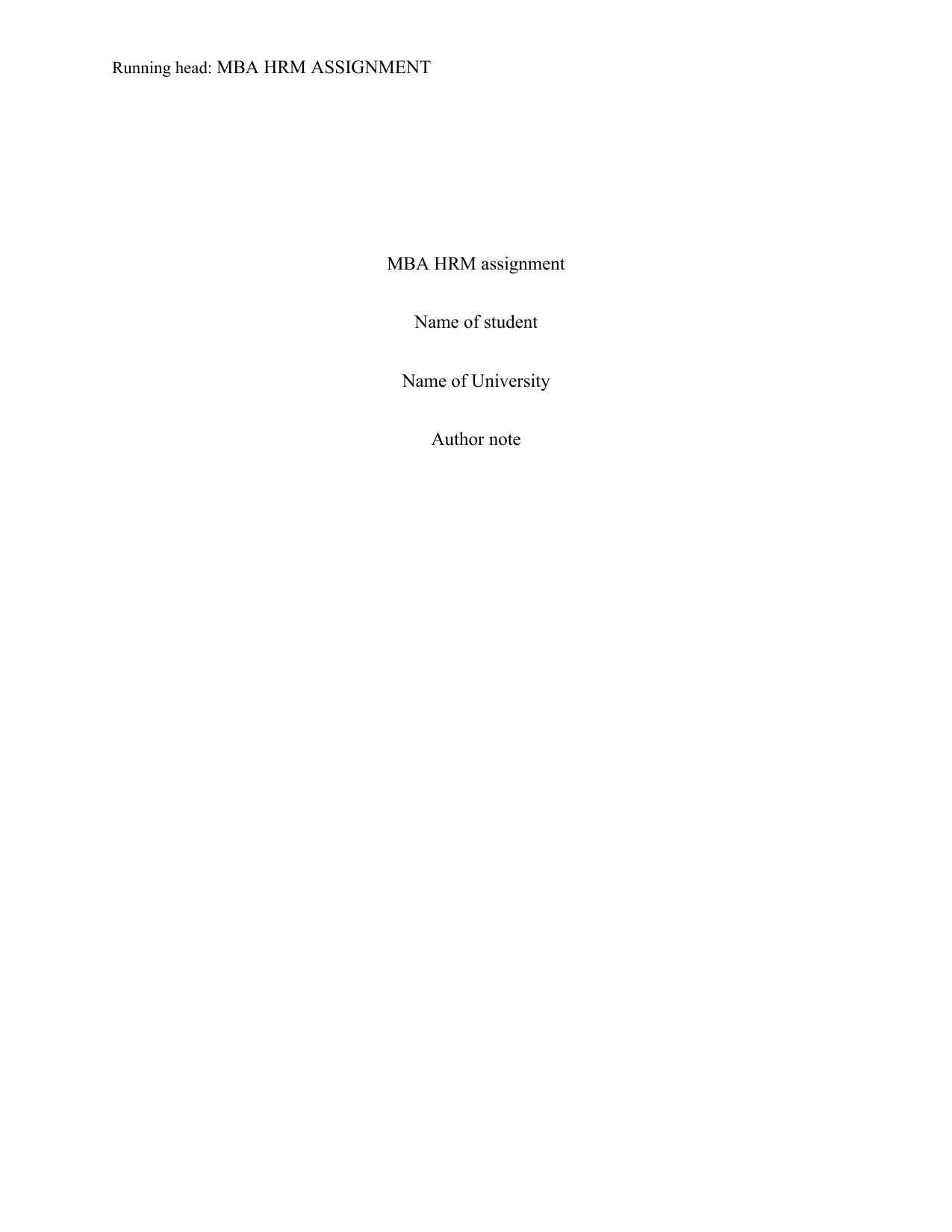
Running head: MBA HRM ASSIGNMENT
MBA HRM assignment
Name of student
Name of University
Author note
MBA HRM assignment
Name of student
Name of University
Author note
Secure Best Marks with AI Grader
Need help grading? Try our AI Grader for instant feedback on your assignments.
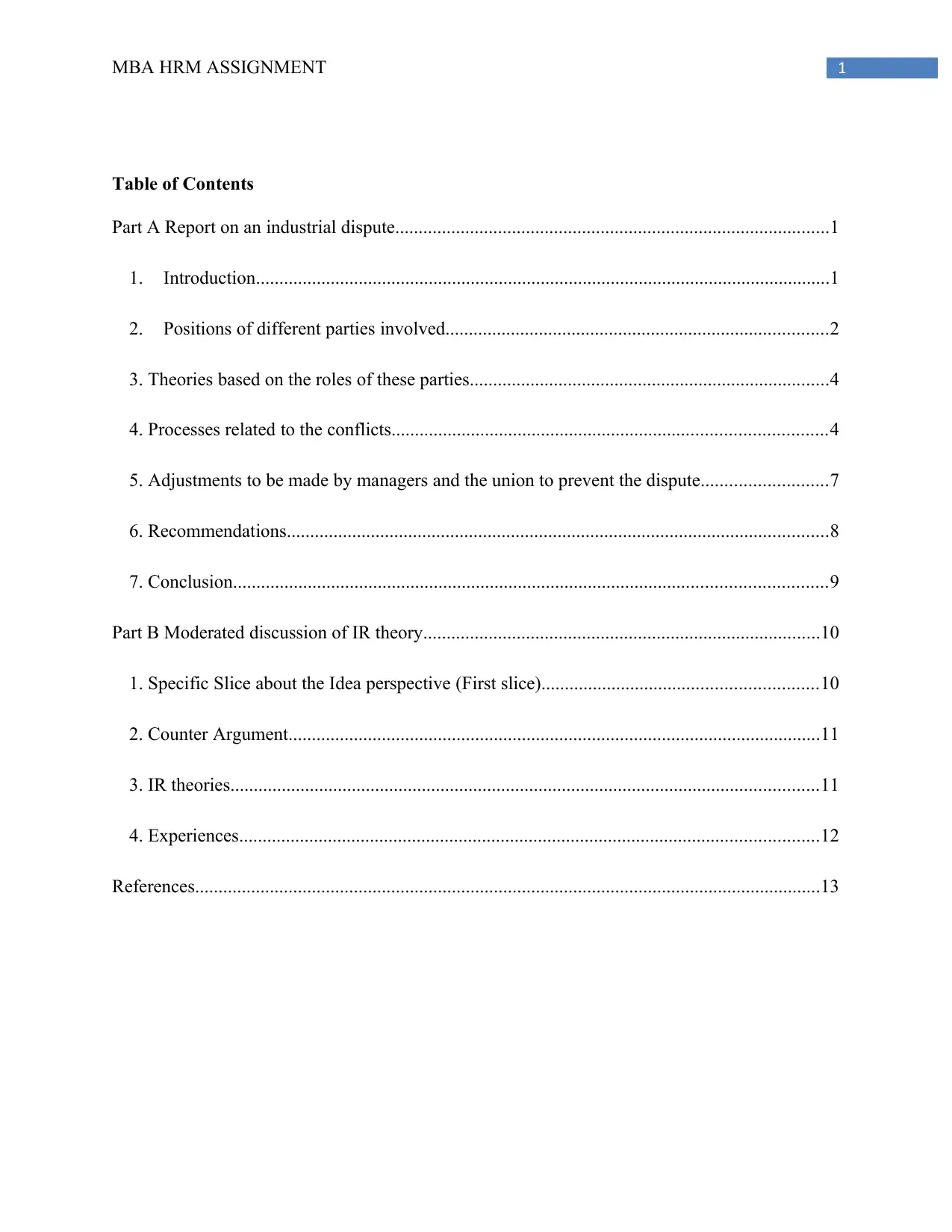
1MBA HRM ASSIGNMENT
Table of Contents
Part A Report on an industrial dispute.............................................................................................1
1. Introduction...........................................................................................................................1
2. Positions of different parties involved..................................................................................2
3. Theories based on the roles of these parties.............................................................................4
4. Processes related to the conflicts.............................................................................................4
5. Adjustments to be made by managers and the union to prevent the dispute...........................7
6. Recommendations....................................................................................................................8
7. Conclusion...............................................................................................................................9
Part B Moderated discussion of IR theory.....................................................................................10
1. Specific Slice about the Idea perspective (First slice)...........................................................10
2. Counter Argument..................................................................................................................11
3. IR theories..............................................................................................................................11
4. Experiences............................................................................................................................12
References......................................................................................................................................13
Table of Contents
Part A Report on an industrial dispute.............................................................................................1
1. Introduction...........................................................................................................................1
2. Positions of different parties involved..................................................................................2
3. Theories based on the roles of these parties.............................................................................4
4. Processes related to the conflicts.............................................................................................4
5. Adjustments to be made by managers and the union to prevent the dispute...........................7
6. Recommendations....................................................................................................................8
7. Conclusion...............................................................................................................................9
Part B Moderated discussion of IR theory.....................................................................................10
1. Specific Slice about the Idea perspective (First slice)...........................................................10
2. Counter Argument..................................................................................................................11
3. IR theories..............................................................................................................................11
4. Experiences............................................................................................................................12
References......................................................................................................................................13

2MBA HRM ASSIGNMENT
Part A Report on an industrial dispute
1. Introduction
The Rail Tram and Bus Union workers were involved in the strike because the wages
provided to them were quite low, which was the major cause of the dispute. Based on their
statements, industrial actions were needed to be undertaken when the NSW and Sydney trains
management did not negotiate a proper enterprise agreement with the workers. RTBU wanted a
hike of 6 percent in their annual pay, though the Government ignored the case situation and only
managed to increase it by 2.5 percent. The topic will illustrate how the conflict will be resolved
and the approaches followed based on the international relations theories (Armstrong & Taylor,
2014).
2. Positions of different parties involved
The major parties involved with the NSW train disputes are the managers, management
staffs, public station and the RTBU. The strike was caused due to the issues associated with the
paying of wages, working conditions and other things that are responsible for creating lack of
interest among the parties. The Sydney train failed to resolve the pay related disputes, due to
which, the NSW workers started to strike (Alfes et al., 2013).
2.1 Unions
Based on the case study, it could be seen that there were conflicts and war of words between
the Union Secretary of NSW and the Transport Minister as well, who were reluctant and even
were not influenced with the actions that were needed to be taken regarding the hike in wages
annually that the Union workers wanted. The Strike started from 12.01 am in the 29th of
Part A Report on an industrial dispute
1. Introduction
The Rail Tram and Bus Union workers were involved in the strike because the wages
provided to them were quite low, which was the major cause of the dispute. Based on their
statements, industrial actions were needed to be undertaken when the NSW and Sydney trains
management did not negotiate a proper enterprise agreement with the workers. RTBU wanted a
hike of 6 percent in their annual pay, though the Government ignored the case situation and only
managed to increase it by 2.5 percent. The topic will illustrate how the conflict will be resolved
and the approaches followed based on the international relations theories (Armstrong & Taylor,
2014).
2. Positions of different parties involved
The major parties involved with the NSW train disputes are the managers, management
staffs, public station and the RTBU. The strike was caused due to the issues associated with the
paying of wages, working conditions and other things that are responsible for creating lack of
interest among the parties. The Sydney train failed to resolve the pay related disputes, due to
which, the NSW workers started to strike (Alfes et al., 2013).
2.1 Unions
Based on the case study, it could be seen that there were conflicts and war of words between
the Union Secretary of NSW and the Transport Minister as well, who were reluctant and even
were not influenced with the actions that were needed to be taken regarding the hike in wages
annually that the Union workers wanted. The Strike started from 12.01 am in the 29th of
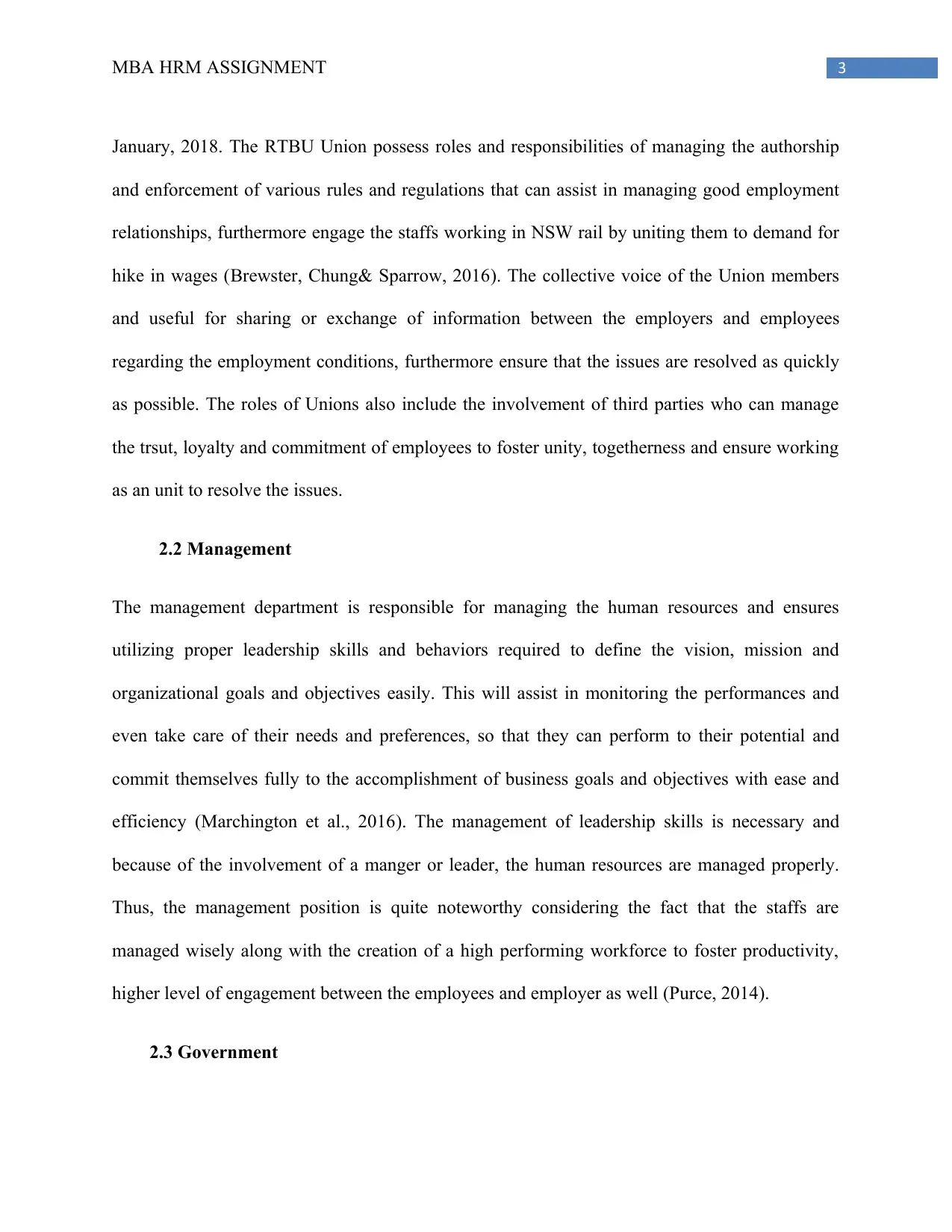
3MBA HRM ASSIGNMENT
January, 2018. The RTBU Union possess roles and responsibilities of managing the authorship
and enforcement of various rules and regulations that can assist in managing good employment
relationships, furthermore engage the staffs working in NSW rail by uniting them to demand for
hike in wages (Brewster, Chung& Sparrow, 2016). The collective voice of the Union members
and useful for sharing or exchange of information between the employers and employees
regarding the employment conditions, furthermore ensure that the issues are resolved as quickly
as possible. The roles of Unions also include the involvement of third parties who can manage
the trsut, loyalty and commitment of employees to foster unity, togetherness and ensure working
as an unit to resolve the issues.
2.2 Management
The management department is responsible for managing the human resources and ensures
utilizing proper leadership skills and behaviors required to define the vision, mission and
organizational goals and objectives easily. This will assist in monitoring the performances and
even take care of their needs and preferences, so that they can perform to their potential and
commit themselves fully to the accomplishment of business goals and objectives with ease and
efficiency (Marchington et al., 2016). The management of leadership skills is necessary and
because of the involvement of a manger or leader, the human resources are managed properly.
Thus, the management position is quite noteworthy considering the fact that the staffs are
managed wisely along with the creation of a high performing workforce to foster productivity,
higher level of engagement between the employees and employer as well (Purce, 2014).
2.3 Government
January, 2018. The RTBU Union possess roles and responsibilities of managing the authorship
and enforcement of various rules and regulations that can assist in managing good employment
relationships, furthermore engage the staffs working in NSW rail by uniting them to demand for
hike in wages (Brewster, Chung& Sparrow, 2016). The collective voice of the Union members
and useful for sharing or exchange of information between the employers and employees
regarding the employment conditions, furthermore ensure that the issues are resolved as quickly
as possible. The roles of Unions also include the involvement of third parties who can manage
the trsut, loyalty and commitment of employees to foster unity, togetherness and ensure working
as an unit to resolve the issues.
2.2 Management
The management department is responsible for managing the human resources and ensures
utilizing proper leadership skills and behaviors required to define the vision, mission and
organizational goals and objectives easily. This will assist in monitoring the performances and
even take care of their needs and preferences, so that they can perform to their potential and
commit themselves fully to the accomplishment of business goals and objectives with ease and
efficiency (Marchington et al., 2016). The management of leadership skills is necessary and
because of the involvement of a manger or leader, the human resources are managed properly.
Thus, the management position is quite noteworthy considering the fact that the staffs are
managed wisely along with the creation of a high performing workforce to foster productivity,
higher level of engagement between the employees and employer as well (Purce, 2014).
2.3 Government
Secure Best Marks with AI Grader
Need help grading? Try our AI Grader for instant feedback on your assignments.
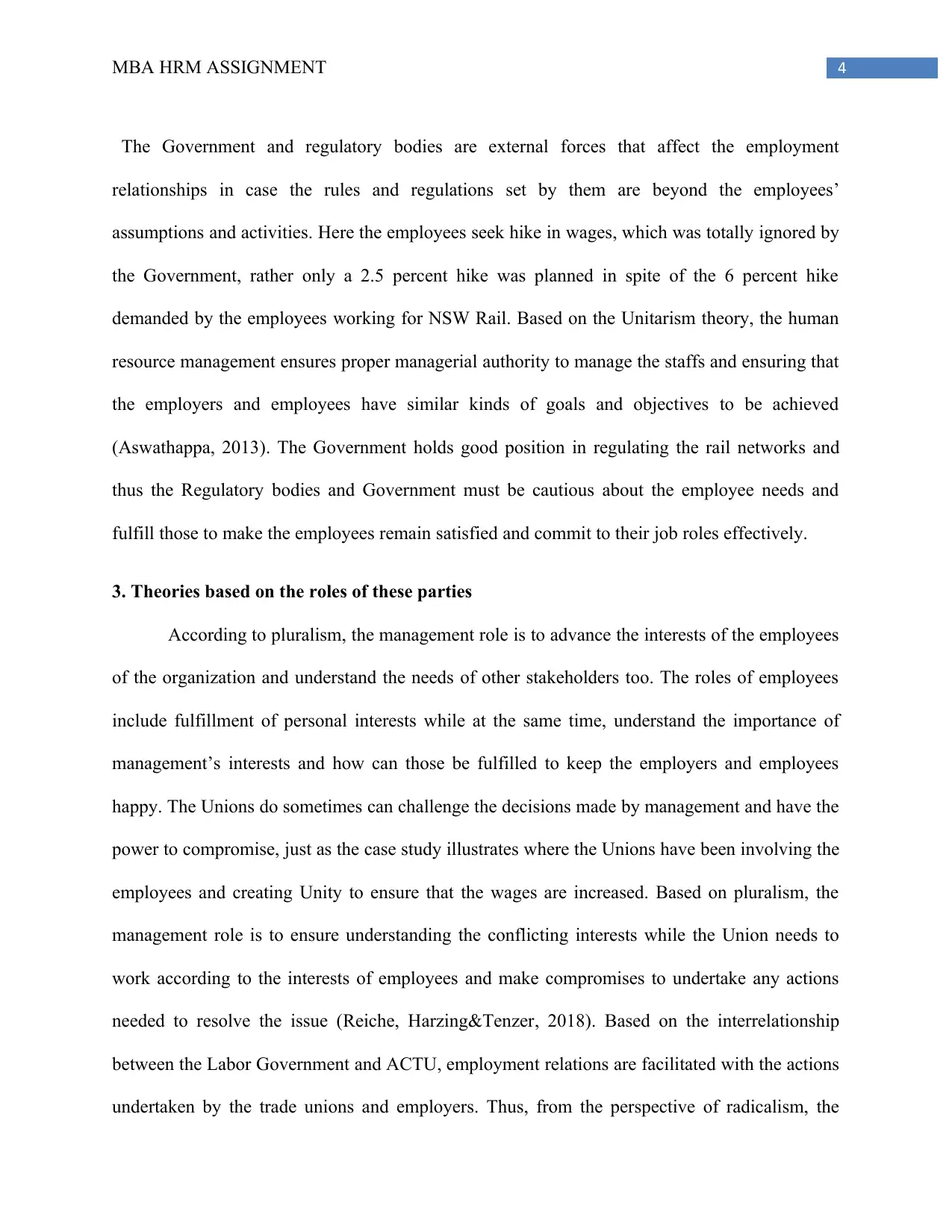
4MBA HRM ASSIGNMENT
The Government and regulatory bodies are external forces that affect the employment
relationships in case the rules and regulations set by them are beyond the employees’
assumptions and activities. Here the employees seek hike in wages, which was totally ignored by
the Government, rather only a 2.5 percent hike was planned in spite of the 6 percent hike
demanded by the employees working for NSW Rail. Based on the Unitarism theory, the human
resource management ensures proper managerial authority to manage the staffs and ensuring that
the employers and employees have similar kinds of goals and objectives to be achieved
(Aswathappa, 2013). The Government holds good position in regulating the rail networks and
thus the Regulatory bodies and Government must be cautious about the employee needs and
fulfill those to make the employees remain satisfied and commit to their job roles effectively.
3. Theories based on the roles of these parties
According to pluralism, the management role is to advance the interests of the employees
of the organization and understand the needs of other stakeholders too. The roles of employees
include fulfillment of personal interests while at the same time, understand the importance of
management’s interests and how can those be fulfilled to keep the employers and employees
happy. The Unions do sometimes can challenge the decisions made by management and have the
power to compromise, just as the case study illustrates where the Unions have been involving the
employees and creating Unity to ensure that the wages are increased. Based on pluralism, the
management role is to ensure understanding the conflicting interests while the Union needs to
work according to the interests of employees and make compromises to undertake any actions
needed to resolve the issue (Reiche, Harzing&Tenzer, 2018). Based on the interrelationship
between the Labor Government and ACTU, employment relations are facilitated with the actions
undertaken by the trade unions and employers. Thus, from the perspective of radicalism, the
The Government and regulatory bodies are external forces that affect the employment
relationships in case the rules and regulations set by them are beyond the employees’
assumptions and activities. Here the employees seek hike in wages, which was totally ignored by
the Government, rather only a 2.5 percent hike was planned in spite of the 6 percent hike
demanded by the employees working for NSW Rail. Based on the Unitarism theory, the human
resource management ensures proper managerial authority to manage the staffs and ensuring that
the employers and employees have similar kinds of goals and objectives to be achieved
(Aswathappa, 2013). The Government holds good position in regulating the rail networks and
thus the Regulatory bodies and Government must be cautious about the employee needs and
fulfill those to make the employees remain satisfied and commit to their job roles effectively.
3. Theories based on the roles of these parties
According to pluralism, the management role is to advance the interests of the employees
of the organization and understand the needs of other stakeholders too. The roles of employees
include fulfillment of personal interests while at the same time, understand the importance of
management’s interests and how can those be fulfilled to keep the employers and employees
happy. The Unions do sometimes can challenge the decisions made by management and have the
power to compromise, just as the case study illustrates where the Unions have been involving the
employees and creating Unity to ensure that the wages are increased. Based on pluralism, the
management role is to ensure understanding the conflicting interests while the Union needs to
work according to the interests of employees and make compromises to undertake any actions
needed to resolve the issue (Reiche, Harzing&Tenzer, 2018). Based on the interrelationship
between the Labor Government and ACTU, employment relations are facilitated with the actions
undertaken by the trade unions and employers. Thus, from the perspective of radicalism, the

5MBA HRM ASSIGNMENT
employment relationship has created a interest conflict between the employers and employees,
which should be resolved by proper negotiations and compromises made (Pha, 2018).
4. Processes related to the conflicts
4.1 Porter’s three types of business strategies
The three different kinds of business strategiesproposed by Porter are cost leadership,
differentiation and focus, all of which are focused on achieving competitive advantage in
business. The cost leadership strategy could enable the railway network to become one of the
lowest cost competitors by providing services at very lower prices to the clients while the
development of unique products and services that can provide superior value and benefits are
considered as differentiation. The focus strategy is prioritized on the targeting a specific market
segment and focus on that only to ensuremaximum revenue generation by fulfilling the demands
and expectations of customers (Bolton, 2015).
4.2 Collective bargaining
The collective bargaining enables setting various rules and regulations that can control
the employment relationships and form a great association between the employer and employees.
The collective agreements are made and as it can be seen from the case study involving the train
strike due to lower wages and bad working conditions, etc (Jackson&Sørensen, 2016). The
collective bargaining is an important part of collective agreement that ensures making the
employees work as an unit with the involvement of unions and negotiate with the employers too.
The bargainingcould enable agreement between both the parties and make a decision with the
consent of both the parties willingly (Miley, 2015). The collective bargaining would include
employment relationship has created a interest conflict between the employers and employees,
which should be resolved by proper negotiations and compromises made (Pha, 2018).
4. Processes related to the conflicts
4.1 Porter’s three types of business strategies
The three different kinds of business strategiesproposed by Porter are cost leadership,
differentiation and focus, all of which are focused on achieving competitive advantage in
business. The cost leadership strategy could enable the railway network to become one of the
lowest cost competitors by providing services at very lower prices to the clients while the
development of unique products and services that can provide superior value and benefits are
considered as differentiation. The focus strategy is prioritized on the targeting a specific market
segment and focus on that only to ensuremaximum revenue generation by fulfilling the demands
and expectations of customers (Bolton, 2015).
4.2 Collective bargaining
The collective bargaining enables setting various rules and regulations that can control
the employment relationships and form a great association between the employer and employees.
The collective agreements are made and as it can be seen from the case study involving the train
strike due to lower wages and bad working conditions, etc (Jackson&Sørensen, 2016). The
collective bargaining is an important part of collective agreement that ensures making the
employees work as an unit with the involvement of unions and negotiate with the employers too.
The bargainingcould enable agreement between both the parties and make a decision with the
consent of both the parties willingly (Miley, 2015). The collective bargaining would include
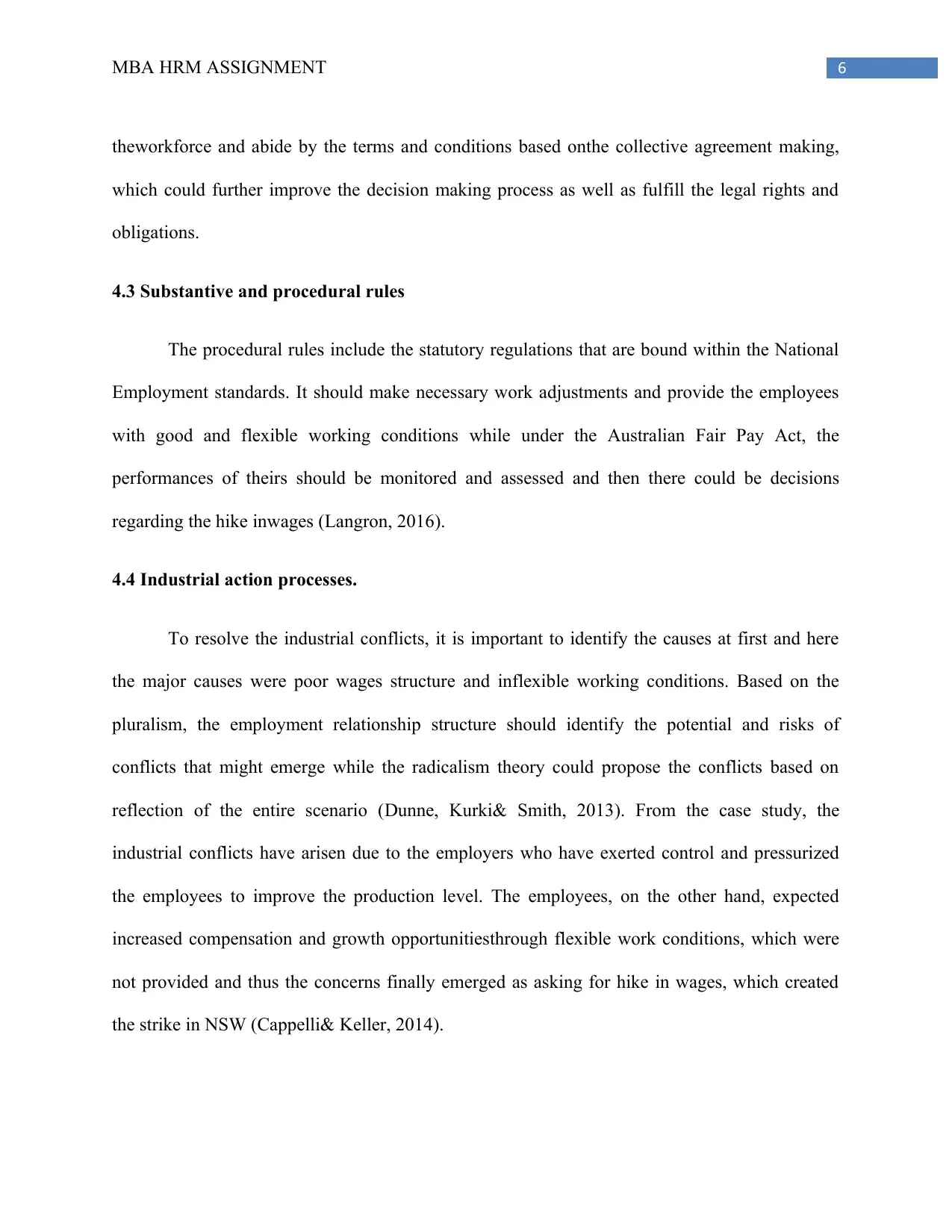
6MBA HRM ASSIGNMENT
theworkforce and abide by the terms and conditions based onthe collective agreement making,
which could further improve the decision making process as well as fulfill the legal rights and
obligations.
4.3 Substantive and procedural rules
The procedural rules include the statutory regulations that are bound within the National
Employment standards. It should make necessary work adjustments and provide the employees
with good and flexible working conditions while under the Australian Fair Pay Act, the
performances of theirs should be monitored and assessed and then there could be decisions
regarding the hike inwages (Langron, 2016).
4.4 Industrial action processes.
To resolve the industrial conflicts, it is important to identify the causes at first and here
the major causes were poor wages structure and inflexible working conditions. Based on the
pluralism, the employment relationship structure should identify the potential and risks of
conflicts that might emerge while the radicalism theory could propose the conflicts based on
reflection of the entire scenario (Dunne, Kurki& Smith, 2013). From the case study, the
industrial conflicts have arisen due to the employers who have exerted control and pressurized
the employees to improve the production level. The employees, on the other hand, expected
increased compensation and growth opportunitiesthrough flexible work conditions, which were
not provided and thus the concerns finally emerged as asking for hike in wages, which created
the strike in NSW (Cappelli& Keller, 2014).
theworkforce and abide by the terms and conditions based onthe collective agreement making,
which could further improve the decision making process as well as fulfill the legal rights and
obligations.
4.3 Substantive and procedural rules
The procedural rules include the statutory regulations that are bound within the National
Employment standards. It should make necessary work adjustments and provide the employees
with good and flexible working conditions while under the Australian Fair Pay Act, the
performances of theirs should be monitored and assessed and then there could be decisions
regarding the hike inwages (Langron, 2016).
4.4 Industrial action processes.
To resolve the industrial conflicts, it is important to identify the causes at first and here
the major causes were poor wages structure and inflexible working conditions. Based on the
pluralism, the employment relationship structure should identify the potential and risks of
conflicts that might emerge while the radicalism theory could propose the conflicts based on
reflection of the entire scenario (Dunne, Kurki& Smith, 2013). From the case study, the
industrial conflicts have arisen due to the employers who have exerted control and pressurized
the employees to improve the production level. The employees, on the other hand, expected
increased compensation and growth opportunitiesthrough flexible work conditions, which were
not provided and thus the concerns finally emerged as asking for hike in wages, which created
the strike in NSW (Cappelli& Keller, 2014).
Paraphrase This Document
Need a fresh take? Get an instant paraphrase of this document with our AI Paraphraser
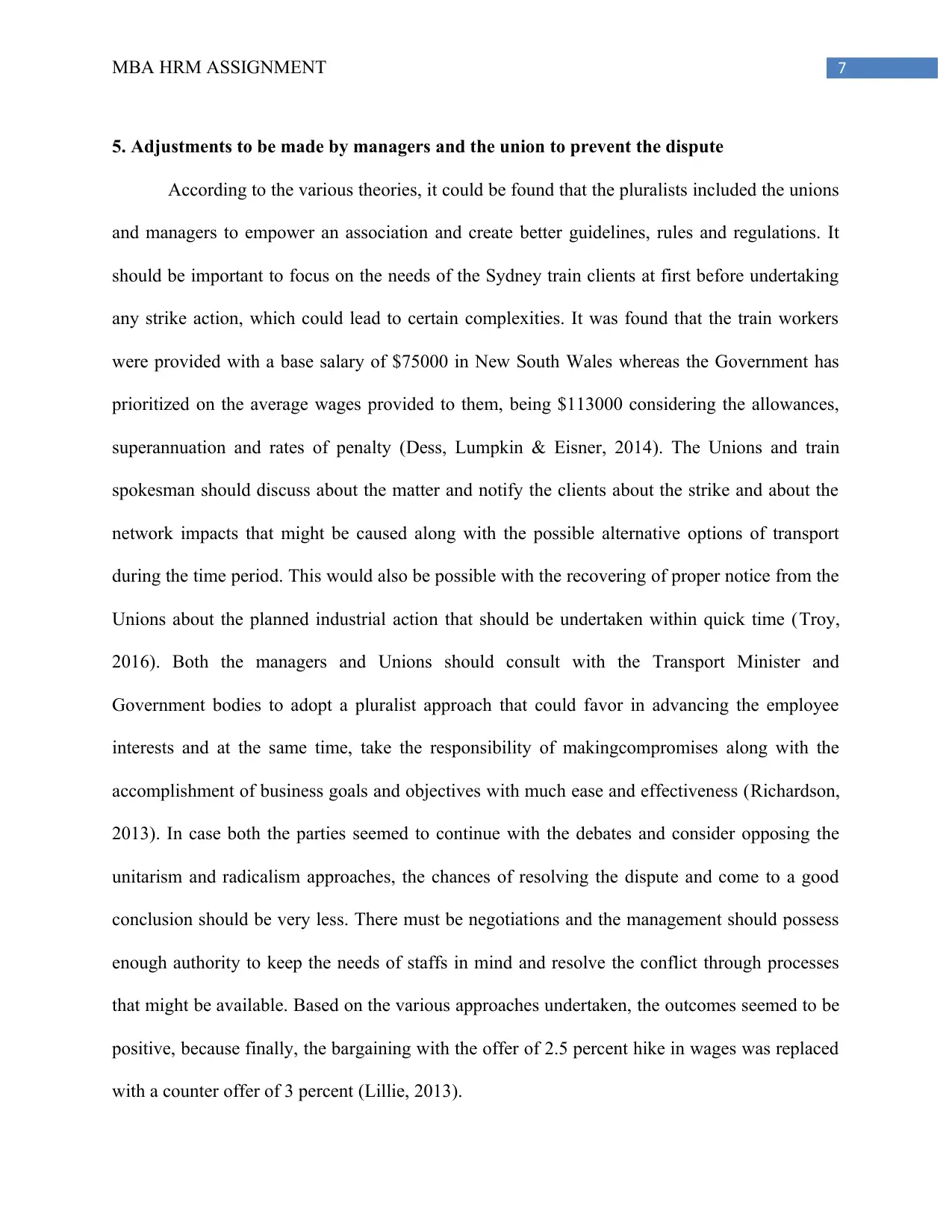
7MBA HRM ASSIGNMENT
5. Adjustments to be made by managers and the union to prevent the dispute
According to the various theories, it could be found that the pluralists included the unions
and managers to empower an association and create better guidelines, rules and regulations. It
should be important to focus on the needs of the Sydney train clients at first before undertaking
any strike action, which could lead to certain complexities. It was found that the train workers
were provided with a base salary of $75000 in New South Wales whereas the Government has
prioritized on the average wages provided to them, being $113000 considering the allowances,
superannuation and rates of penalty (Dess, Lumpkin & Eisner, 2014). The Unions and train
spokesman should discuss about the matter and notify the clients about the strike and about the
network impacts that might be caused along with the possible alternative options of transport
during the time period. This would also be possible with the recovering of proper notice from the
Unions about the planned industrial action that should be undertaken within quick time (Troy,
2016). Both the managers and Unions should consult with the Transport Minister and
Government bodies to adopt a pluralist approach that could favor in advancing the employee
interests and at the same time, take the responsibility of makingcompromises along with the
accomplishment of business goals and objectives with much ease and effectiveness (Richardson,
2013). In case both the parties seemed to continue with the debates and consider opposing the
unitarism and radicalism approaches, the chances of resolving the dispute and come to a good
conclusion should be very less. There must be negotiations and the management should possess
enough authority to keep the needs of staffs in mind and resolve the conflict through processes
that might be available. Based on the various approaches undertaken, the outcomes seemed to be
positive, because finally, the bargaining with the offer of 2.5 percent hike in wages was replaced
with a counter offer of 3 percent (Lillie, 2013).
5. Adjustments to be made by managers and the union to prevent the dispute
According to the various theories, it could be found that the pluralists included the unions
and managers to empower an association and create better guidelines, rules and regulations. It
should be important to focus on the needs of the Sydney train clients at first before undertaking
any strike action, which could lead to certain complexities. It was found that the train workers
were provided with a base salary of $75000 in New South Wales whereas the Government has
prioritized on the average wages provided to them, being $113000 considering the allowances,
superannuation and rates of penalty (Dess, Lumpkin & Eisner, 2014). The Unions and train
spokesman should discuss about the matter and notify the clients about the strike and about the
network impacts that might be caused along with the possible alternative options of transport
during the time period. This would also be possible with the recovering of proper notice from the
Unions about the planned industrial action that should be undertaken within quick time (Troy,
2016). Both the managers and Unions should consult with the Transport Minister and
Government bodies to adopt a pluralist approach that could favor in advancing the employee
interests and at the same time, take the responsibility of makingcompromises along with the
accomplishment of business goals and objectives with much ease and effectiveness (Richardson,
2013). In case both the parties seemed to continue with the debates and consider opposing the
unitarism and radicalism approaches, the chances of resolving the dispute and come to a good
conclusion should be very less. There must be negotiations and the management should possess
enough authority to keep the needs of staffs in mind and resolve the conflict through processes
that might be available. Based on the various approaches undertaken, the outcomes seemed to be
positive, because finally, the bargaining with the offer of 2.5 percent hike in wages was replaced
with a counter offer of 3 percent (Lillie, 2013).
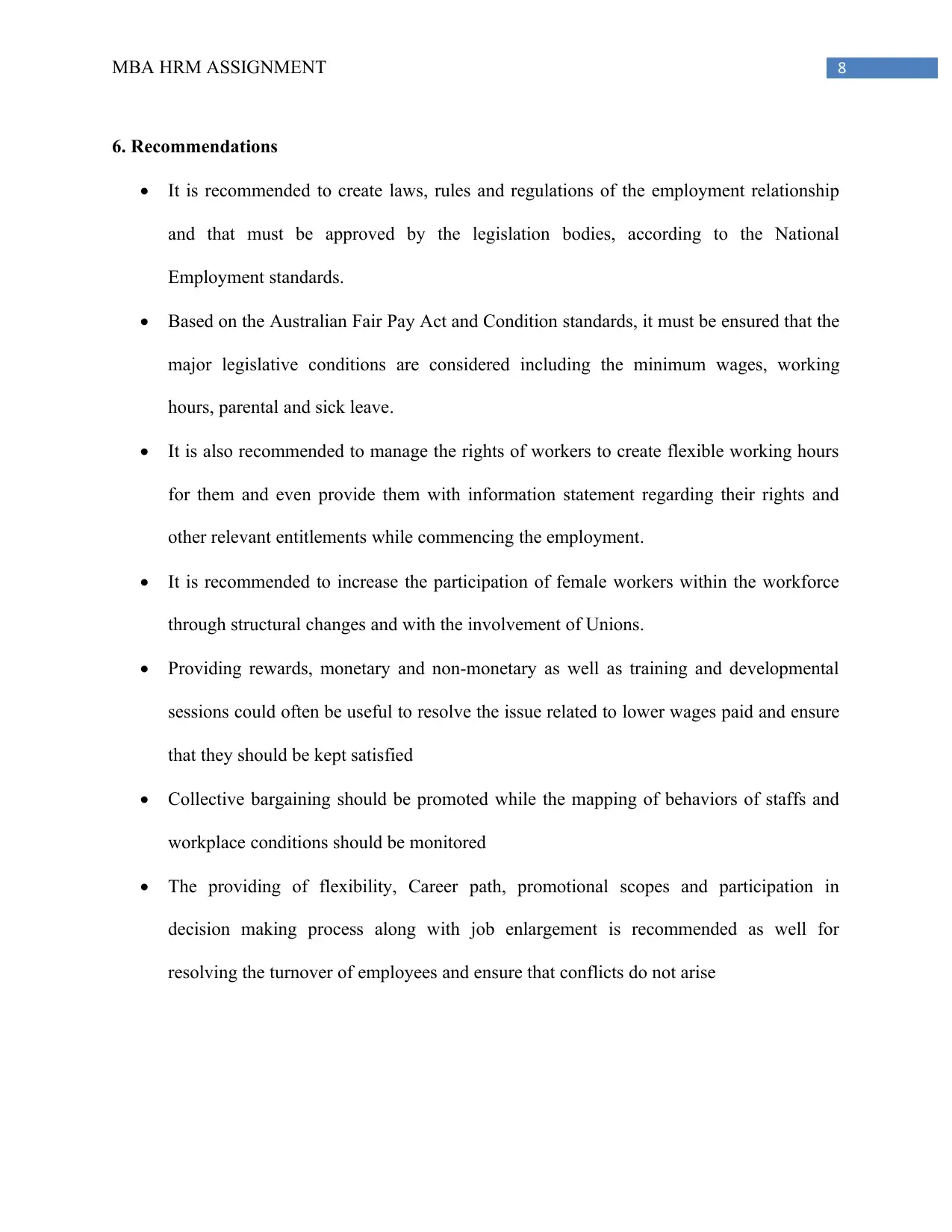
8MBA HRM ASSIGNMENT
6. Recommendations
It is recommended to create laws, rules and regulations of the employment relationship
and that must be approved by the legislation bodies, according to the National
Employment standards.
Based on the Australian Fair Pay Act and Condition standards, it must be ensured that the
major legislative conditions are considered including the minimum wages, working
hours, parental and sick leave.
It is also recommended to manage the rights of workers to create flexible working hours
for them and even provide them with information statement regarding their rights and
other relevant entitlements while commencing the employment.
It is recommended to increase the participation of female workers within the workforce
through structural changes and with the involvement of Unions.
Providing rewards, monetary and non-monetary as well as training and developmental
sessions could often be useful to resolve the issue related to lower wages paid and ensure
that they should be kept satisfied
Collective bargaining should be promoted while the mapping of behaviors of staffs and
workplace conditions should be monitored
The providing of flexibility, Career path, promotional scopes and participation in
decision making process along with job enlargement is recommended as well for
resolving the turnover of employees and ensure that conflicts do not arise
6. Recommendations
It is recommended to create laws, rules and regulations of the employment relationship
and that must be approved by the legislation bodies, according to the National
Employment standards.
Based on the Australian Fair Pay Act and Condition standards, it must be ensured that the
major legislative conditions are considered including the minimum wages, working
hours, parental and sick leave.
It is also recommended to manage the rights of workers to create flexible working hours
for them and even provide them with information statement regarding their rights and
other relevant entitlements while commencing the employment.
It is recommended to increase the participation of female workers within the workforce
through structural changes and with the involvement of Unions.
Providing rewards, monetary and non-monetary as well as training and developmental
sessions could often be useful to resolve the issue related to lower wages paid and ensure
that they should be kept satisfied
Collective bargaining should be promoted while the mapping of behaviors of staffs and
workplace conditions should be monitored
The providing of flexibility, Career path, promotional scopes and participation in
decision making process along with job enlargement is recommended as well for
resolving the turnover of employees and ensure that conflicts do not arise
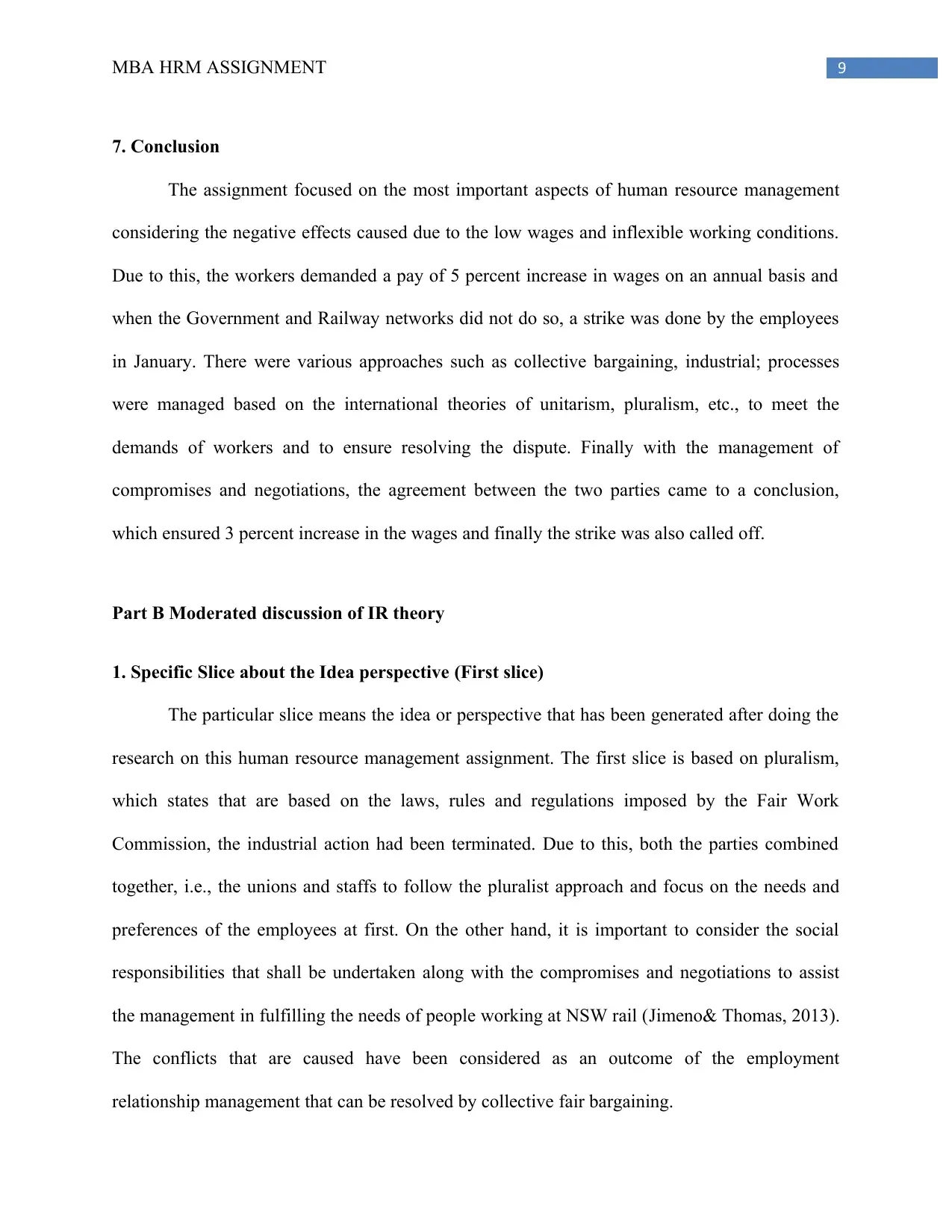
9MBA HRM ASSIGNMENT
7. Conclusion
The assignment focused on the most important aspects of human resource management
considering the negative effects caused due to the low wages and inflexible working conditions.
Due to this, the workers demanded a pay of 5 percent increase in wages on an annual basis and
when the Government and Railway networks did not do so, a strike was done by the employees
in January. There were various approaches such as collective bargaining, industrial; processes
were managed based on the international theories of unitarism, pluralism, etc., to meet the
demands of workers and to ensure resolving the dispute. Finally with the management of
compromises and negotiations, the agreement between the two parties came to a conclusion,
which ensured 3 percent increase in the wages and finally the strike was also called off.
Part B Moderated discussion of IR theory
1. Specific Slice about the Idea perspective (First slice)
The particular slice means the idea or perspective that has been generated after doing the
research on this human resource management assignment. The first slice is based on pluralism,
which states that are based on the laws, rules and regulations imposed by the Fair Work
Commission, the industrial action had been terminated. Due to this, both the parties combined
together, i.e., the unions and staffs to follow the pluralist approach and focus on the needs and
preferences of the employees at first. On the other hand, it is important to consider the social
responsibilities that shall be undertaken along with the compromises and negotiations to assist
the management in fulfilling the needs of people working at NSW rail (Jimeno& Thomas, 2013).
The conflicts that are caused have been considered as an outcome of the employment
relationship management that can be resolved by collective fair bargaining.
7. Conclusion
The assignment focused on the most important aspects of human resource management
considering the negative effects caused due to the low wages and inflexible working conditions.
Due to this, the workers demanded a pay of 5 percent increase in wages on an annual basis and
when the Government and Railway networks did not do so, a strike was done by the employees
in January. There were various approaches such as collective bargaining, industrial; processes
were managed based on the international theories of unitarism, pluralism, etc., to meet the
demands of workers and to ensure resolving the dispute. Finally with the management of
compromises and negotiations, the agreement between the two parties came to a conclusion,
which ensured 3 percent increase in the wages and finally the strike was also called off.
Part B Moderated discussion of IR theory
1. Specific Slice about the Idea perspective (First slice)
The particular slice means the idea or perspective that has been generated after doing the
research on this human resource management assignment. The first slice is based on pluralism,
which states that are based on the laws, rules and regulations imposed by the Fair Work
Commission, the industrial action had been terminated. Due to this, both the parties combined
together, i.e., the unions and staffs to follow the pluralist approach and focus on the needs and
preferences of the employees at first. On the other hand, it is important to consider the social
responsibilities that shall be undertaken along with the compromises and negotiations to assist
the management in fulfilling the needs of people working at NSW rail (Jimeno& Thomas, 2013).
The conflicts that are caused have been considered as an outcome of the employment
relationship management that can be resolved by collective fair bargaining.
Secure Best Marks with AI Grader
Need help grading? Try our AI Grader for instant feedback on your assignments.

10MBA HRM ASSIGNMENT
The HRM position should be assessed and monitored to check whether the staffs are
managed properly or not along with the management of a proper leadership style. The
transformation leadership style could be beneficial as because it would consider the sharing and
exchanging of ideas between the employees and at the same time, facilitate group thinking and
improve the process of decision making as well. The pluralist idea perspective could also allow
the management to increase the wages provided to the employees, furthermore make
negotiations and resolve the conflict that might have emerged with the outcomes that have been
mutually agreed upon by both the parties (Veblen, 2017).
2. Counter Argument
While the plurailism approach to employment relation management is considered as
effective, still it has been believed that the unitarism approach could enable the interests of
employees to gain more capital through increase in wages contrary to the NSW Government and
Sydney train networks. While the advances in NES promotes the rights of workers to ask for
flexible working conditions along with minimum notice for redundancy and termination, it is to
be noted that giving too much freedom to the employees could result in affecting the
performance of the workforce negatively sometimes too (Kemmis, McTaggart& Nixon, 2013).
3. IR theories
The international relations theory manages proper understanding of the international
relationships based on the theories and concepts and create a framework for analysis and
interpretation of the relations needed to keep the occurrences of disputes prevented. The realism
theory enables management of discipline to make decisions according to idealistic thinking. The
constructivism theory, on the other hand, argued the fact that the international relations reality
The HRM position should be assessed and monitored to check whether the staffs are
managed properly or not along with the management of a proper leadership style. The
transformation leadership style could be beneficial as because it would consider the sharing and
exchanging of ideas between the employees and at the same time, facilitate group thinking and
improve the process of decision making as well. The pluralist idea perspective could also allow
the management to increase the wages provided to the employees, furthermore make
negotiations and resolve the conflict that might have emerged with the outcomes that have been
mutually agreed upon by both the parties (Veblen, 2017).
2. Counter Argument
While the plurailism approach to employment relation management is considered as
effective, still it has been believed that the unitarism approach could enable the interests of
employees to gain more capital through increase in wages contrary to the NSW Government and
Sydney train networks. While the advances in NES promotes the rights of workers to ask for
flexible working conditions along with minimum notice for redundancy and termination, it is to
be noted that giving too much freedom to the employees could result in affecting the
performance of the workforce negatively sometimes too (Kemmis, McTaggart& Nixon, 2013).
3. IR theories
The international relations theory manages proper understanding of the international
relationships based on the theories and concepts and create a framework for analysis and
interpretation of the relations needed to keep the occurrences of disputes prevented. The realism
theory enables management of discipline to make decisions according to idealistic thinking. The
constructivism theory, on the other hand, argued the fact that the international relations reality
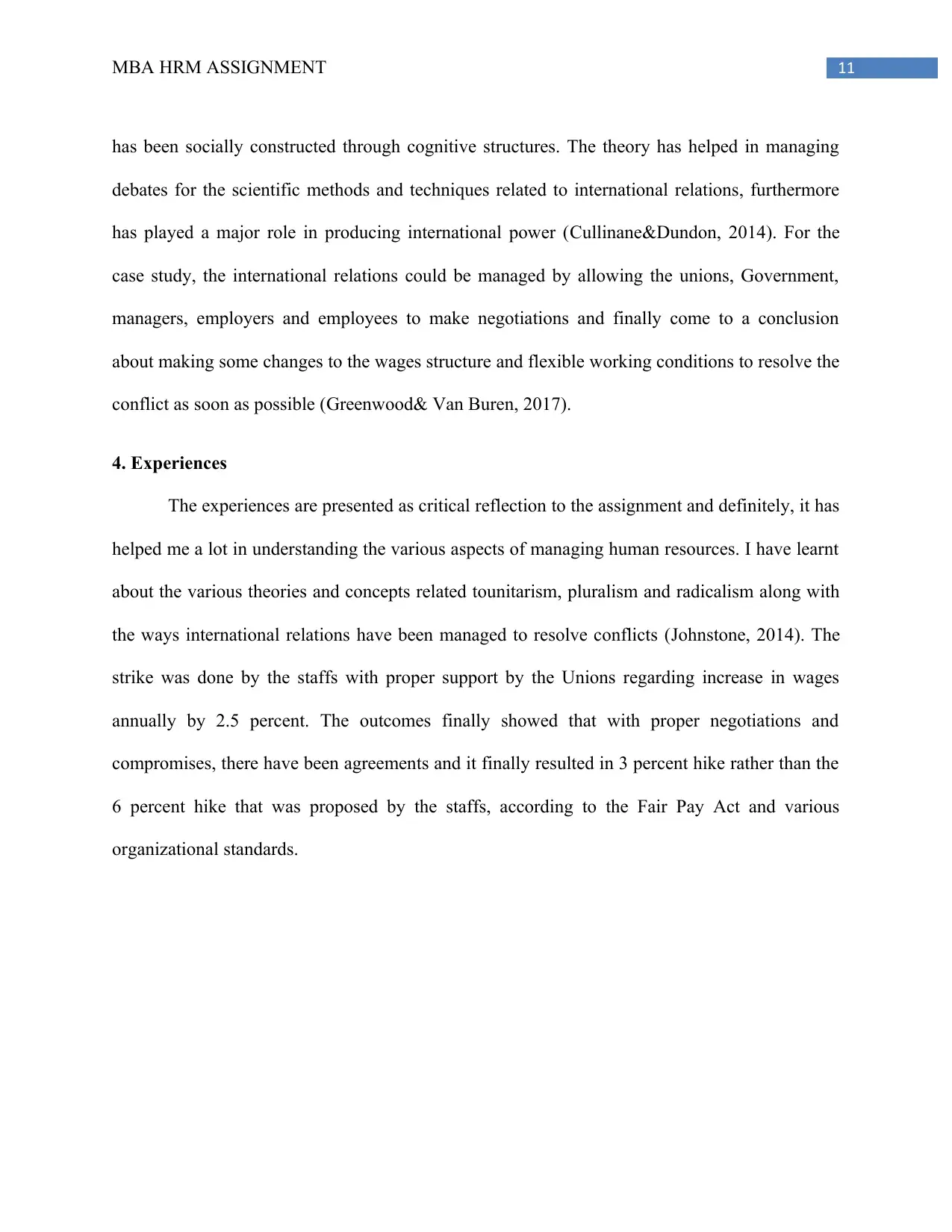
11MBA HRM ASSIGNMENT
has been socially constructed through cognitive structures. The theory has helped in managing
debates for the scientific methods and techniques related to international relations, furthermore
has played a major role in producing international power (Cullinane&Dundon, 2014). For the
case study, the international relations could be managed by allowing the unions, Government,
managers, employers and employees to make negotiations and finally come to a conclusion
about making some changes to the wages structure and flexible working conditions to resolve the
conflict as soon as possible (Greenwood& Van Buren, 2017).
4. Experiences
The experiences are presented as critical reflection to the assignment and definitely, it has
helped me a lot in understanding the various aspects of managing human resources. I have learnt
about the various theories and concepts related tounitarism, pluralism and radicalism along with
the ways international relations have been managed to resolve conflicts (Johnstone, 2014). The
strike was done by the staffs with proper support by the Unions regarding increase in wages
annually by 2.5 percent. The outcomes finally showed that with proper negotiations and
compromises, there have been agreements and it finally resulted in 3 percent hike rather than the
6 percent hike that was proposed by the staffs, according to the Fair Pay Act and various
organizational standards.
has been socially constructed through cognitive structures. The theory has helped in managing
debates for the scientific methods and techniques related to international relations, furthermore
has played a major role in producing international power (Cullinane&Dundon, 2014). For the
case study, the international relations could be managed by allowing the unions, Government,
managers, employers and employees to make negotiations and finally come to a conclusion
about making some changes to the wages structure and flexible working conditions to resolve the
conflict as soon as possible (Greenwood& Van Buren, 2017).
4. Experiences
The experiences are presented as critical reflection to the assignment and definitely, it has
helped me a lot in understanding the various aspects of managing human resources. I have learnt
about the various theories and concepts related tounitarism, pluralism and radicalism along with
the ways international relations have been managed to resolve conflicts (Johnstone, 2014). The
strike was done by the staffs with proper support by the Unions regarding increase in wages
annually by 2.5 percent. The outcomes finally showed that with proper negotiations and
compromises, there have been agreements and it finally resulted in 3 percent hike rather than the
6 percent hike that was proposed by the staffs, according to the Fair Pay Act and various
organizational standards.
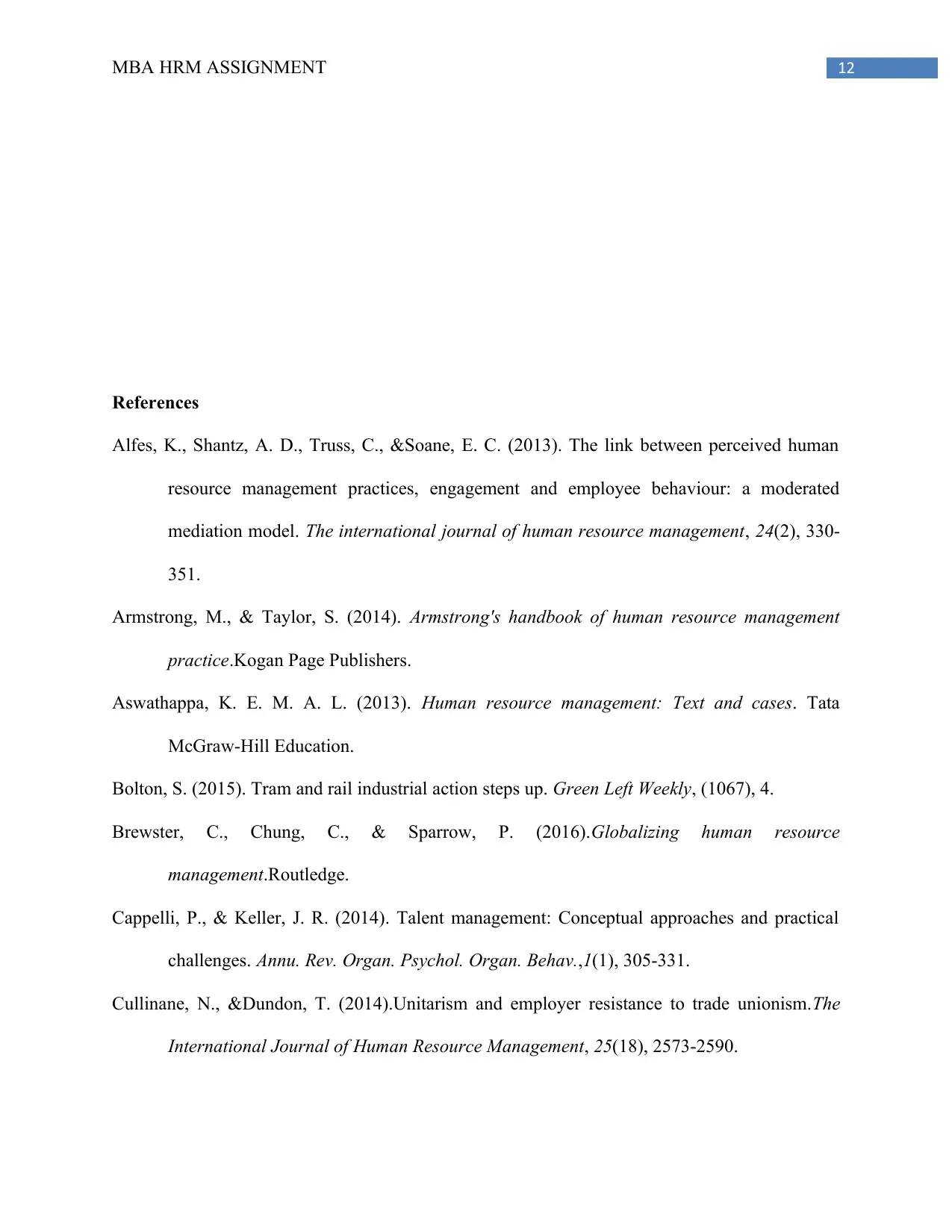
12MBA HRM ASSIGNMENT
References
Alfes, K., Shantz, A. D., Truss, C., &Soane, E. C. (2013). The link between perceived human
resource management practices, engagement and employee behaviour: a moderated
mediation model. The international journal of human resource management, 24(2), 330-
351.
Armstrong, M., & Taylor, S. (2014). Armstrong's handbook of human resource management
practice.Kogan Page Publishers.
Aswathappa, K. E. M. A. L. (2013). Human resource management: Text and cases. Tata
McGraw-Hill Education.
Bolton, S. (2015). Tram and rail industrial action steps up. Green Left Weekly, (1067), 4.
Brewster, C., Chung, C., & Sparrow, P. (2016).Globalizing human resource
management.Routledge.
Cappelli, P., & Keller, J. R. (2014). Talent management: Conceptual approaches and practical
challenges. Annu. Rev. Organ. Psychol. Organ. Behav.,1(1), 305-331.
Cullinane, N., &Dundon, T. (2014).Unitarism and employer resistance to trade unionism.The
International Journal of Human Resource Management, 25(18), 2573-2590.
References
Alfes, K., Shantz, A. D., Truss, C., &Soane, E. C. (2013). The link between perceived human
resource management practices, engagement and employee behaviour: a moderated
mediation model. The international journal of human resource management, 24(2), 330-
351.
Armstrong, M., & Taylor, S. (2014). Armstrong's handbook of human resource management
practice.Kogan Page Publishers.
Aswathappa, K. E. M. A. L. (2013). Human resource management: Text and cases. Tata
McGraw-Hill Education.
Bolton, S. (2015). Tram and rail industrial action steps up. Green Left Weekly, (1067), 4.
Brewster, C., Chung, C., & Sparrow, P. (2016).Globalizing human resource
management.Routledge.
Cappelli, P., & Keller, J. R. (2014). Talent management: Conceptual approaches and practical
challenges. Annu. Rev. Organ. Psychol. Organ. Behav.,1(1), 305-331.
Cullinane, N., &Dundon, T. (2014).Unitarism and employer resistance to trade unionism.The
International Journal of Human Resource Management, 25(18), 2573-2590.
Paraphrase This Document
Need a fresh take? Get an instant paraphrase of this document with our AI Paraphraser

13MBA HRM ASSIGNMENT
Dess, G. G., Lumpkin, G. T., & Eisner, A. B. (2014).Strategic management: Text and cases.
McGraw-Hill Education.
Dunne, T., Kurki, M., & Smith, S. (Eds.). (2013). International relations theories.Oxford
University Press.
Greenwood, M., & Van Buren, H. J. (2017). Ideology in HRM scholarship: Interrogating the
ideological performativity of ‘New Unitarism’. Journal of Business Ethics, 142(4), 663-
678.
Jackson, R., &Sørensen, G. (2016).Introduction to international relations: theories and
approaches. Oxford university press.
Jimeno, J. F., & Thomas, C. (2013).Collective bargaining, firm heterogeneity and
unemployment.European Economic Review, 59, 63-79.
Johnstone, S. (2014).Workplace partnership.Handbook of research on employee voice.
Cheltenham: Edward Elgar Publishing. Google Scholar.
Kemmis, S., McTaggart, R., & Nixon, R. (2013). The action research planner: Doing critical
participatory action research. Springer Science & Business Media.
Langron, J. W. (2016). Real staff engagement for a sustainable safety culture.CORE 2016:
Maintaining the Momentum, 364.
Lillie, N. (2013). A global union for global workers: collective bargaining and regulatory
politics in maritime shipping. Routledge.
Marchington, M., Wilkinson, A., Donnelly, R., &Kynighou, A. (2016).Human resource
management at work.Kogan Page Publishers.
Miley, V. (2015). System does not care about workers. Green Left Weekly, (1069), 2.
Pha, A. (2018). Strength in unity.Guardian (Sydney), (1808), 1.
Dess, G. G., Lumpkin, G. T., & Eisner, A. B. (2014).Strategic management: Text and cases.
McGraw-Hill Education.
Dunne, T., Kurki, M., & Smith, S. (Eds.). (2013). International relations theories.Oxford
University Press.
Greenwood, M., & Van Buren, H. J. (2017). Ideology in HRM scholarship: Interrogating the
ideological performativity of ‘New Unitarism’. Journal of Business Ethics, 142(4), 663-
678.
Jackson, R., &Sørensen, G. (2016).Introduction to international relations: theories and
approaches. Oxford university press.
Jimeno, J. F., & Thomas, C. (2013).Collective bargaining, firm heterogeneity and
unemployment.European Economic Review, 59, 63-79.
Johnstone, S. (2014).Workplace partnership.Handbook of research on employee voice.
Cheltenham: Edward Elgar Publishing. Google Scholar.
Kemmis, S., McTaggart, R., & Nixon, R. (2013). The action research planner: Doing critical
participatory action research. Springer Science & Business Media.
Langron, J. W. (2016). Real staff engagement for a sustainable safety culture.CORE 2016:
Maintaining the Momentum, 364.
Lillie, N. (2013). A global union for global workers: collective bargaining and regulatory
politics in maritime shipping. Routledge.
Marchington, M., Wilkinson, A., Donnelly, R., &Kynighou, A. (2016).Human resource
management at work.Kogan Page Publishers.
Miley, V. (2015). System does not care about workers. Green Left Weekly, (1069), 2.
Pha, A. (2018). Strength in unity.Guardian (Sydney), (1808), 1.
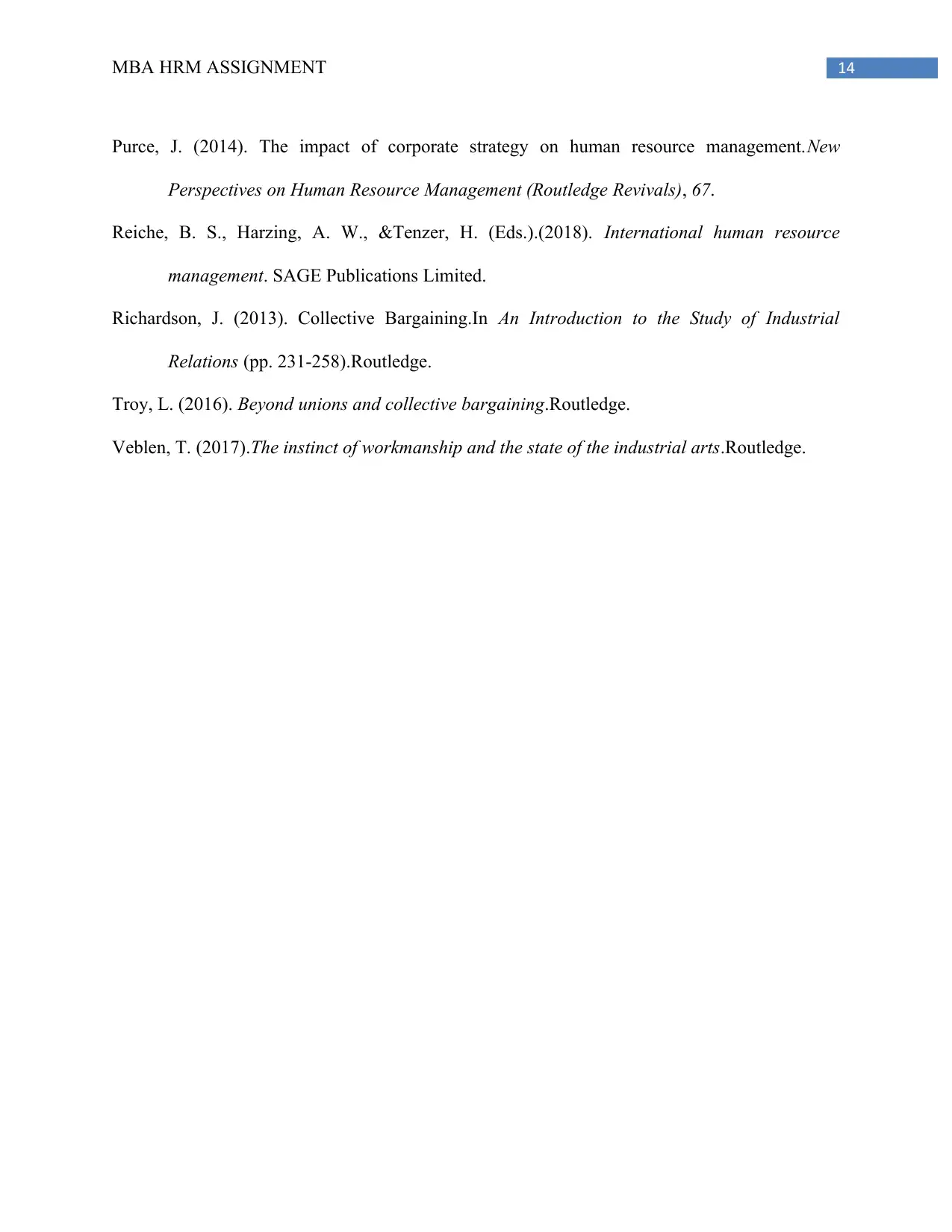
14MBA HRM ASSIGNMENT
Purce, J. (2014). The impact of corporate strategy on human resource management.New
Perspectives on Human Resource Management (Routledge Revivals), 67.
Reiche, B. S., Harzing, A. W., &Tenzer, H. (Eds.).(2018). International human resource
management. SAGE Publications Limited.
Richardson, J. (2013). Collective Bargaining.In An Introduction to the Study of Industrial
Relations (pp. 231-258).Routledge.
Troy, L. (2016). Beyond unions and collective bargaining.Routledge.
Veblen, T. (2017).The instinct of workmanship and the state of the industrial arts.Routledge.
Purce, J. (2014). The impact of corporate strategy on human resource management.New
Perspectives on Human Resource Management (Routledge Revivals), 67.
Reiche, B. S., Harzing, A. W., &Tenzer, H. (Eds.).(2018). International human resource
management. SAGE Publications Limited.
Richardson, J. (2013). Collective Bargaining.In An Introduction to the Study of Industrial
Relations (pp. 231-258).Routledge.
Troy, L. (2016). Beyond unions and collective bargaining.Routledge.
Veblen, T. (2017).The instinct of workmanship and the state of the industrial arts.Routledge.
1 out of 15
Related Documents
Your All-in-One AI-Powered Toolkit for Academic Success.
+13062052269
info@desklib.com
Available 24*7 on WhatsApp / Email
![[object Object]](/_next/static/media/star-bottom.7253800d.svg)
Unlock your academic potential
© 2024 | Zucol Services PVT LTD | All rights reserved.




